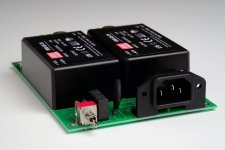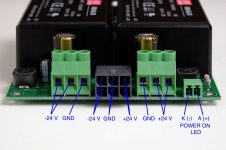This looks like it would do the trick for 2 (or possibly 4 channels if not driven to the limit) worth of Neurochrome 3886 in a car application: 300W Boost Converter for Car Audio TL494 | eBay
If you can connect two of these units in series to get ±28 V, yes. As-is, one of these modules will only provide a positive voltage. You need the negative as well.
Tom
Ok! Something for me to ponder. My speaker cables are ~ 20 ft long (low capacitance) and my speakers are 96 dB efficient. I don't know if that makes any difference from a "lowest droop" standpoint.
The droop is caused by the voltage divider formed by the cable and the driver impedances.
From a psychoacoustic standpoint I dislike the concept of having your equipment in the same room, let alone between the speakers. I listen in the dark, and find the experience far more pleasurable!
You can always put your gear inside a piece of furniture between the speakers. As long as it has enough airflow available to stay cool, life's good.
Tom
If you only saw my room. It doubles as a theater. The only thing in the middle is an acoustically transparent screen. But there is some space behind the screen.
Best,
Anand.
Best,
Anand.
I thought something like Belden 1309A cable in 14awg would be good for a 20 foot run. Spec.s are; OFHC copper, PO insulation, Inductance = .16uH/ft, Cap = 20.5pF/ft, DCR = 2.5Ohm/1,000ft. Price is about $1 per/ft.
If you only saw my room. It doubles as a theater. The only thing in the middle is an acoustically transparent screen. But there is some space behind the screen.
A friend of mine has a room like that. Yeah... That's a rather immersing way of experiencing music.
I thought something like Belden 1309A cable in 14awg would be good for a 20 foot run. Spec.s are; OFHC copper, PO insulation, Inductance = .16uH/ft, Cap = 20.5pF/ft, DCR = 2.5Ohm/1,000ft. Price is about $1 per/ft.
I like it.
I've used Talent SC1250 (2 x 12 AWG, round jacket). Seems to conduct electrons just fine. For my LXmini speakers, I used some Dayton 4 x 13 AWG cable. The 4-conductor cable is super convenient with the LXminis. Add a speakON connector on either end of the cable. Plug in, twist, "click", DONE! Gotta love the speakON connectors.
Tom
Just saw on the page it is "Galvanically isolated output"
Care to share the topology? I know buck/boost (Cuk) is an ideal one (zero ripple) but they are rarely found in the wild
Care to share the topology? I know buck/boost (Cuk) is an ideal one (zero ripple) but they are rarely found in the wild
I'm using a pre-fabricated PCB-mount module. I don't know the topology. I'm guessing it's a forward converter of some sort. It's 90 % efficient.
Tom
Tom
... (snip) ...
Cutting oil is a must. I don't think I've broken a tap since I started using cutting fluid (knock on wood!) I use A-9 – not to be confused with A-1 steak sauce. I don't think A-1 works for cutting aluminum and A-9 tastes awful! 🙂
Tom
You're in Canada now, Tom. We use HP Sauce here, A-1 is for south of the border.
You're in Canada now, Tom. We use HP Sauce here, A-1 is for south of the border.
I've noticed. I like it! I grew up with HP sauce actually.
But like your other products it is through hole?
Back on topic: There are two SMD components on the SMPS-86: The two inductors in the output filter. They're 12.7 mm square and their terminals extend slightly past the edge of the part. They do take some heat to get soldered onto the board, but they won't challenge your eyesight any more than leaded parts - unlike other SMD bits. I did look at getting leaded inductors, but I wasn't confident they'd be available long-term.
Tom
Golden syrup? Or is the Canadian one horrid corn syrup these days like in the US? I can't believe Lyle allowed such a thing to happen. It should be just refined cane sugar!
I think you understand that I want to power two pair of 90dB B&W speakers with one amp. I'm pretty sure the mod86 won't be capable. Would a Parallel-86 work or would the addition of the SMPS-86 with a Mod86 also work?If you need long cable runs, I strongly recommend using differential signalling. A THAT Driver in a small enclosure will work. It'll need a power supply. A Power-86 with a small transformer will work. My hot-off-the-press SMPS-86 is overkill but will work just fine as well.
Tom
I would need a diagram or picture of where the SMPS-86 would reside. Questions that come to mind are; does it replace the Power86, does it go in the Mod86 amp case, ect.?
Latest member of the Neurochrome product portfolio: SMPS-86.
It's intended to be panel mounted on a panel no thicker than 4.0 mm. International mains in. ±24 V out. 2.85 mV RMS (20 Hz - 20 kHz) output noise.
For more information on the SMPS-86, please see its product page: SMPS-86: Switch-mode power supply for audio amplifiers.
Tom
It's intended to be panel mounted on a panel no thicker than 4.0 mm. International mains in. ±24 V out. 2.85 mV RMS (20 Hz - 20 kHz) output noise.
For more information on the SMPS-86, please see its product page: SMPS-86: Switch-mode power supply for audio amplifiers.
Tom
Attachments
Last edited:
Golden syrup? Or is the Canadian one horrid corn syrup these days like in the US? I can't believe Lyle allowed such a thing to happen. It should be just refined cane sugar!
Roger's Golden Syrup, which you can buy at the supermarket in Canada, and is the No1 selling brand, is 100% Cane Sugar. That, plus No1 Medium Pure Maple Syrup, and E.D Smith's "No Sugar Added" table syrup (which has no real sugar in it) are what you find at my house for adding to your pancakes, or ice cream.
You can get the Corn Syrup here but it's called "Corn Syrup". Most people don't buy it because it's relatively expensive.
Because we don't have tariffs on sugars in Canada, any form of sugar, domestic or imported, is cheaper than Corn Syrup (which is the most expensive form of sugar). We generally grow our own sugars for domestic consumption, so common white sugar is made from Sugar Beets, typically from Alberta.
In the US they use Corn-derived sugars because it is the least expensive, but don't take that to mean it's cheap.
The lower cost of Corn sugars in US domestic manufacture is relative to the alternatives; the US doesn't grow much in the way of Beet Sugars, they have prohibitive tariffs on sugar imports, they have other non-tariff barriers that outright ban sugar imports from any country that trades with Cuba (which means everyone in the Americas except America), and they subsidize corn production (corn actually sells for less than the cost of production, farmers are compensated for the difference).
I guess I started this off-topic discussion with my A1/HP remark, so I suppose it's all my fault. But ideally we would get back on topic, perhaps?
Last edited:
I guess I just missed the edit time-out. DOH! The attached picture shows the pinout of the connectors and terminal blocks on the SMPS-86.
The output voltages are provided on terminal blocks with a rising cage clamping mechanism. These terminal blocks accept wire up to AWG 10 (5.2 mm2). The output voltages are also provided on a Molex MegaFit connector for better compatibility with the LM3886DR. The power on indicator LED is connected via a EURO-style connector.
Tom
The output voltages are provided on terminal blocks with a rising cage clamping mechanism. These terminal blocks accept wire up to AWG 10 (5.2 mm2). The output voltages are also provided on a Molex MegaFit connector for better compatibility with the LM3886DR. The power on indicator LED is connected via a EURO-style connector.
Tom
Attachments
What can I say Tom? It's gorgeous! I will have to order one (or two) soon to play...I'll send you an email with my questions...
Best,
Anand.
Best,
Anand.
" ... I guess I started this off-topic discussion with my A1/HP remark, so I suppose it's all my fault. But ideally we would get back on topic, perhaps? ..."
And on that note, my own Modulus-86 build (a mono-block) is slowly but surely coming to the assembly stage. I am still gathering parts, and have a budget that means it's a multi-month process, even though it's not terribly expensive. Part of the parts cost is I'm buying enough to build two units, although I only presently have boards for one and plans for a single monoblock unit.
I'm still working on the details, but after looking at so many pre-built enclosures and the typically prohibitive shipping costs to Canada (often more than the enclosure itself) I've decided to make my own from scratch.
Two weeks ago I went out to buy the parts I need to build a metal brake ($4 in surplus materials) that will bend 20" wide steel or aluminum.
Raw metals here are inexpensive (same as or less than the online prices in the US, with $0 added shipping costs) and I plan to fab up my heatsink. Haven't decided on copper (brazed) or aluminum (welded) yet, will depend on the cost of 12 feet of 0.375" rod. But for what it would cost me to land a plain aluminum / steel box, I can make something from scratch that I think would look better. We'll see, I guess.
And on that note, my own Modulus-86 build (a mono-block) is slowly but surely coming to the assembly stage. I am still gathering parts, and have a budget that means it's a multi-month process, even though it's not terribly expensive. Part of the parts cost is I'm buying enough to build two units, although I only presently have boards for one and plans for a single monoblock unit.
I'm still working on the details, but after looking at so many pre-built enclosures and the typically prohibitive shipping costs to Canada (often more than the enclosure itself) I've decided to make my own from scratch.
Two weeks ago I went out to buy the parts I need to build a metal brake ($4 in surplus materials) that will bend 20" wide steel or aluminum.
Raw metals here are inexpensive (same as or less than the online prices in the US, with $0 added shipping costs) and I plan to fab up my heatsink. Haven't decided on copper (brazed) or aluminum (welded) yet, will depend on the cost of 12 feet of 0.375" rod. But for what it would cost me to land a plain aluminum / steel box, I can make something from scratch that I think would look better. We'll see, I guess.
But ideally we would get back on topic, perhaps? ..."
I'll follow your lead.
I'm still working on the details, but after looking at so many pre-built enclosures and the typically prohibitive shipping costs to Canada (often more than the enclosure itself) I've decided to make my own from scratch.
You may want to have a look at ModuShop. Their 2U Dissipante series would be perfect for a MOD86 build. That's what Henry used.
I did the math at one point. Heat sinks from Heatsink USA, metal from Online Metals. If I recall correctly, the total was about $100 for 3 mm thick panels, 10 mm front panel. I paid about $150 shipped for the eBay chassis (BZ4309). ModuShop runs about $135 including shipping. You can get the ModuShop chassis through the DIY Audio Store as well.
Tom
- Home
- Amplifiers
- Chip Amps
- Modulus-86 build thread

